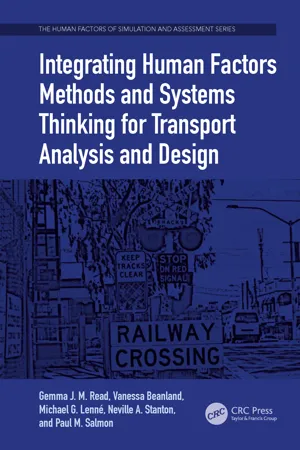
Integrating Human Factors Methods and Systems Thinking for Transport Analysis and Design
- 292 pages
- English
- ePUB (mobile friendly)
- Available on iOS & Android
Integrating Human Factors Methods and Systems Thinking for Transport Analysis and Design
About This Book
Governments and road safety agencies around the world have either introduced or are considering 'safe system' strategies, a long overdue acknowledgement that different elements of the road system contribute to road safety outcomes. Human factors approaches have a leading role here in both conceptualising the road system as a complex sociotechnical system and in providing practical approaches to support true systems-based countermeasures. This book illustrates the potential for integrating contemporary systems-based human factors methods with modern day driving-assessment methods, such as vehicle instrumentation and driving simulation, to understand and enhance performance in modern day road-transport systems. The book outlines why a fundamental paradigm shift is needed in the way these systems are designed and operated, and illustrates how a wide range of accepted human-factors approaches can be applied successfully to road transport to revolutionise the countermeasure design process. The practical illustrations of these human factors methods are applied to a long-standing road and rail safety issue: rail level crossings, where the road and rail systems intersect. The final chapter of the book highlights the utility of the human factors approach to reducing road trauma and discusses future applications of the approach.
Frequently asked questions
Information
Table of contents
- Cover
- Half Title
- Title Page
- Copyright Page
- Dedication
- Table of Contents
- Preface
- Acknowledgements
- About the Authors
- SECTION I Introduction to the Research Approach
- SECTION II Rail Level Crossing Data Collection and Analysis
- SECTION III Design of New Rail Level Crossing Environments
- SECTION IV Evaluation of Design Concepts
- SECTION V Conclusions and Future Applications
- Appendix: Guidance for Using the Key Human Factors Methods and Approaches
- References
- Index